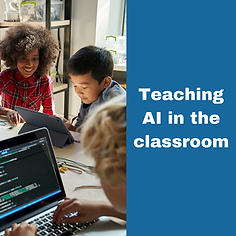

AI is the future
Children today are growing up around artificial intelligence but just because they are growing up around it does not mean they understand what it is or know how it works.
So, what is Artificial Intelligence? The theory and development of computer systems are able to perform tasks that normally require human intelligence, such as visual perception, speech recognition, decision-making, and translation between languages.
Artificial Intelligence has found its way into our daily lives, and we don’t even realize we are using it every day. Ever wonder how Google gives you such accurate search results? Or how your social media feed gives you content based on your interests?
Our phones unlock themselves using facial recognition, we talk to Alexa, Siri, and Cortana to adjust the temperature in our homes, turn off our lights, adjust the volume or change the channel on our televisions. Our cars are driving themselves and even know when a stranger is walking around them, so they turn on their video cameras and record their every move.
AI is definitely changing the world around us, affecting present and future generations, and since AI will only continue to grow, it is important to provide children with the tools needed to understand how it works and the importance of ethics in AI. Teaching children about AI will help them understand the risks and benefits of this technology and continue to encourage innovative solutions to real-world problems, in addition to securing tomorrow's jobs.
Children are already interacting with AI technologies in many different ways, starting from a very young age: AI is embedded in toys, video games, and adaptive learning software. Algorithms provide recommendations to children on what videos to watch next, what music to listen to, and games to play, but how can we start to teach such a complex topic?
During the 2021 Global STEM Leadership Alliance Summit, Jamie Sachs, Senior Director of Education for UBTech Education, a division of UBTech – global leaders in intelligent, humanoid robots for consumers, business, and industry, talked about the importance of teaching children about Artificial Intelligence and why we need to be doing it now. Jaime provided information on where teachers can find resources to teach about AI in their classroom and what their students should be learning as they progress through K-12.
AI4k12.org is a new organization that is a joint initiative of AAAI (Association for the Advancement of Artificial Intelligence), CSTA (Computer Science Teachers Association), Carnegie Mellon University, and funded by NSF (National Science Foundation). They have been working together with MIT, University of Florida, IBM, Microsoft, other colleges, and nonprofit organizations interested in teaching about AI on how AI can be taught at the K12 level and what the different grade levels should be learning. Together, they came up with the national guidelines for teaching AI in K-12, modeled after the CSTA standards for computing education.
The guidelines for teaching children about AI were developed around five big ideas, which organize the framework for the K-12 guidelines.
-
PERCEPTION – The way a computer perceives the world through sensors. This is the extraction of meaning from sensory signals in computers and our senses in humans. Children need a deeper understanding of how senses are used by the brain to make decisions. Animals and humans use senses in different ways; therefore, it’s important for children to understand that there are different senses so they can then understand how computers gather information from that.
-
REPRESENTATION AND REASONING – Once information is gathered through sensors and senses, we then create models that create predictions. Models are representations that computers use. Once computers take information from a sensor, they make sense of that data through algorithms or computer programs. Children can start to understand this by creating models they can first understand, such as creating a family tree and how that represents their family. Children can look at each other’s family tree and talk about how they are interpreting what they see to help them understand predictions.
-
LEARNING – Once models are created, you can learn from additional new data, make predictions, identify patterns, and create data sets.
-
NATURAL INTERACTION – Is understanding how humans communicate, facial expression, body language, speech, emotions, and how to apply this to a computer or robot.
-
SOCIETAL IMPACT – Teaching children the ethics in AI and how it affects society.
Helpful Resources for Teaching Children About AI in the Classroom
A Resource Directory at http://AI4K12.org: https://github.com/touretzkyds/ai4k12/wiki/Resource-Directory contains links to lots of good introductory material on AI, including some excellent videos and sample activities teachers can use for each grade level
Poster of the Five Big Ideas in Artificial Intelligence can be found here: https://ai4k12.org/wp-content/uploads/2021/01/AI4K12_Five_Big_Ideas_Poster-1.pdf
Additional teaching resources on teaching AI in the classroom are available on the UBTECH education website: https://info.ubtecheducation.com/ai-foundations-curriculum . They include sample activities for each grade level.
Google also has a collection of resources for teaching AI to kids at home and in the classroom: https://experiments.withgoogle.com/collection/ai
